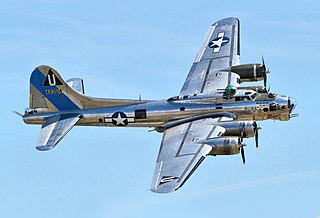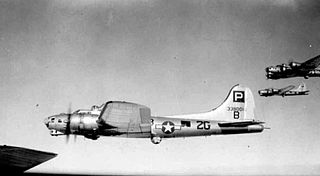Related Research Articles

The Boeing B-17 Flying Fortress is a four-engined heavy bomber developed in the 1930s for the United States Army Air Corps (USAAC). Competing against Douglas and Martin for a contract to build 200 bombers, the Boeing entry outperformed both competitors and exceeded the Air Corps' performance specifications. Although Boeing lost the contract because the prototype crashed, the Air Corps ordered 13 more B-17s for further evaluation. From its introduction in 1938, the B-17 Flying Fortress evolved through numerous design advances, becoming the third-most produced bomber of all time, behind the four-engined Consolidated B-24 Liberator and the multirole, twin-engined Junkers Ju 88.
Bomber Command is an organisational military unit, generally subordinate to the air force of a country. The best known were in Britain and the United States. A Bomber Command is generally used for strategic bombing, and is composed of bombers.

Robert Knight Morgan was a colonel and a Command Pilot in the United States Air Force from Asheville, North Carolina. During World War II, while a captain in the United States Army Air Forces, Morgan was a bomber pilot with the 8th Air Force in the European theater and the aircraft commander of the famous B-17 Flying Fortress, Memphis Belle, flying 25 missions. After completing his European tour, Morgan flew another 26 combat missions in the B-29 Superfortress against Japan in the Pacific Theater.

Royal Air Force Station Polebrook or more simply RAF Polebrook is a former Royal Air Force station located 3.5 miles (5.6 km) east-south-east of Oundle, at Polebrook, Northamptonshire, England. The airfield was built on Rothschild estate land starting in August 1940.

Frank Alton Armstrong Jr. was a lieutenant general of the United States Air Force. As a brigadier general in the United States Army Air Forces during World War II, he was the inspiration for the main character in the novel and subsequent film, Twelve O'Clock High. After the war, he held a variety of senior leadership positions prior to and following the establishment of the USAF as an independent service in 1947. Promoted to major general in 1950, he advanced to lieutenant general in 1956 and retired at that rank in 1961.

The Memphis Belle: A Story of a Flying Fortress is a 1944 documentary film which provides an account of the final mission of the crew of the Memphis Belle, a Boeing B-17 Flying Fortress. In May 1943 it became the third U.S. Army Air Forces heavy bomber to complete 25 missions over Europe, but the first to return to the United States.

Royal Air Force Grafton Underwood or more simply RAF Grafton Underwood is a former Royal Air Force station located 4 miles (6.4 km) northeast of Kettering, Northamptonshire, England.

The 487th Air Expeditionary Wing is a provisional United States Air Force unit assigned to the United States Air Forces in Europe. As a provisional unit, it may be activated or inactivated at any time. The unit's last known assignment was in 2003 at Cairo West Air Base, Egypt, during Operation Iraqi Freedom.

The 45th Air Division is an inactive United States Air Force unit. Its last assignment was with Eighth Air Force at Pease Air Force Base, New Hampshire. It was inactivated on 14 June 1989.

Wings Up is a short propaganda film produced during World War II, highlighting the role of the United States Army Air Forces Officer Candidate School. The film emphasized that while usually these courses would take up to a year in college, the country was at war now and needed all the qualified officers it could get and fast. The curriculum is briefly outlined in Wings Up as well as the kind of life a student would lead at this training center.

The 490th Bombardment Group is a former United States Army Air Forces unit. The group was activated in October 1943. After training in the United States, it deployed to the European Theater of Operations and participated in the strategic bombing campaign against Germany from 31 May 1944 to 20 April 1945, losing 22 aircraft while flying more than 5,000 sorties. Following V-E Day, the group returned to the United States, where it was inactivated in November 1945.

The 303rd Air Expeditionary Group is a provisional United States Air Force unit. In 2011, it was assigned to United States Air Forces Europe to activate or inactivate as needed.

The 327th Bombardment Squadron is an inactive United States Air Force unit. It was last assigned to the 4170th Strategic Wing, stationed at Larson Air Force Base, Washington. It was inactivated on 1 February 1963.

The 869th Bombardment Squadron is a former United States Army Air Forces unit. It was assigned to the 497th Bombardment Group, and was last stationed at MacDill Field, Florida where it was inactivated on 31 March 1946. The squadron was activated in late 1943. After training in the United States, it moved to Saipan, where it served in the strategic bombing campaign against Japan with Twentieth Air Force, flying Boeing B-29 Superfortress aircraft in the Pacific Theater of Operations, where it earned two Distinguished Unit Citations. Following V-J Day, the squadron returned to the United States and briefly became part of Strategic Air Command before inactivating.

The 870th Bombardment Squadron is a former United States Army Air Forces unit. It was assigned to the 497th Bombardment Group, and was last stationed at MacDill Field, Florida where it was inactivated on 31 March 1946. The squadron was activated in late 1943. After training in the United States, it moved to Saipan, where it served in the strategic bombing campaign against Japan with Twentieth Air Force, flying Boeing B-29 Superfortress aircraft in the Pacific Theater of Operations, where it earned two Distinguished Unit Citations. Following V-J Day, the squadron returned to the United States and briefly became part of Strategic Air Command before inactivating.

The 871st Bombardment Squadron is an inactive United States Air Force unit. During World War II it was assigned to the 497th Bombardment Group until it was inactivated on 31 March 1946. The squadron was activated in late 1943. After training in the United States, it moved to Saipan, where it served in the strategic bombing campaign against Japan with Twentieth Air Force, flying Boeing B-29 Superfortress aircraft in the Pacific Theater of Operations, where it earned two Distinguished Unit Citations. Following V-J Day, the squadron returned to the United States and briefly became part of Strategic Air Command before inactivating.

The 836th Bombardment Squadron was a United States Army Air Forces unit. It was activated in September 1943. After training in the United States, it deployed to the European Theater of Operations, where it engaged in combat in the strategic bombing campaign against Germany with Consolidated B-24 Liberators. In the summer of 1944, it was withdrawn from combat to convert to the Boeing B-17 Flying Fortress, then continued in combat with the 487th Bombardment Group until the spring of 1945. Following V-E Day, the squadron returned to Drew Field, Florida, where it was inactivated on 7 November 1945.

This is a list of United States Army Air Forces B-17 Flying Fortress units of the United States Army Air Forces, including variants and other historical information. Heavy bomber training organizations primarily under II Bomber Command in the United States and non-combat units are not included.

Bombing the Nazis is a 10-minute 1943 Canadian documentary film, made by the National Film Board of Canada (NFB) as part of the World War II newsreels shown at theatres in Canada and abroad. The film describes the Allied air war over Europe during the Second World War, concentrating on attacks in 1942 and 1943 on an automobile factory in Vichy France.
References
- Mission Accomplished: The Story of the Flying Fortress, 1943. United States Office of War Information.
- "Internet Archive: Details: Mission Accomplished: The Story of the Flying Fortress". Internet Archive. Accessed on 2007-12-22.